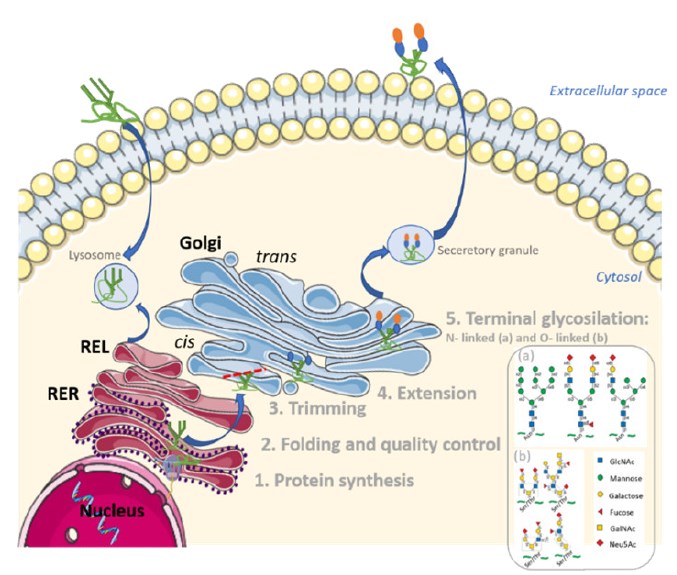Background of Glycoproteins
What are Glycoproteins?
Glycoproteins are proteins that contain covalently bound oligosaccharides (glycans). Glycoproteins and glycolipids are major components of the outer surface of mammalian cells. They are found on the surface of the lipid bilayer of cell membranes. Glycoproteins are fundamental to many important biological processes including fertilization, immune defense, viral replication, parasitic infection, cell growth, cell-cell adhesion, degradation of blood clots, and inflammation.
 Fig.1 Initiation and maturation of glycoproteins in the ER-Golgi-plasma membrane pathway.1, 2
Fig.1 Initiation and maturation of glycoproteins in the ER-Golgi-plasma membrane pathway.1, 2
O-linked and N-linked Glycoproteins
Glycoproteins are classified according to where carbohydrates bind to amino acids in proteins.
-
O-linked glycoproteins are glycoproteins that bind carbohydrates to the oxygen atom (O) of the hydroxyl (-OH) of the R group of the amino acid threonine or serine. This process is called O-glycosylation.
-
N-linked glycoproteins have a carbohydrate that binds to nitrogen (N) of the amino group (-NH2) of the asparagine amino acid R group. The bonding process is called N-glycosylation. N-linked glycoproteins obtain sugar from the endoplasmic reticulum membrane and then are transported to the Golgi complex for modification.
In addition to the common O-linked and N-linked glycoprotein forms, there are several other connections:
-
P-glycosylation refers to the process when sugar binds to phosphorus in phosphoserine;
-
C-glycosylation refers to the binding of sugar to the carbon atom of amino acid. For example, mannose binds to the carbon bond in tryptophan;
-
Glypiation is when a glycophosphatidylinositol (GPI) glycolipid attaches to the carbon terminus of a polypeptide.
Clinical Importance of Glycoproteins
There are many kinds of glycoproteins and they play many important roles in the human body. For example, special glycoproteins on the surface of red blood cells determine blood type, immunoglobulins contribute to immunity, collagen provides structure, and glycoproteins on the surface of viruses act as natural targets for the body to produce antibodies. In addition, some hormones are glycoproteins.
Both N-glycans and O-glycans play an important role in the functions of the glycoprotein involved in various cell recognition signals and pathological situations, so they are potentially potent and reliable biomarkers of various diseases. Because of the large number of biological processes in which glycans participate, it is not surprising that defects in the synthesis of glycans can be the direct cause of numerous diseases and, therefore, markers of the disease. In general, the most studied glycoproteins of clinical importance are the glycoproteins of the cell membrane, whose glycans, called glycocalyx, play important roles in the immune response.
Technologies Used to Study Glycoproteins at Creative Biolabs
A variety of methods used in the detection, purification, and structural analysis of glycoproteins are as follows:
Glycoproteins Related Services at Creative Biolabs
The majority of the world’s best-selling biotherapeutics are glycoproteins. They are involved in many important biological pathways. As a world-leading biotechnology company, Creative Biolabs has accumulated extensive experience in glycoprotein research, we can offer custom services for glycoprotein projects, including but not limited to:
References
-
Fuertes-Martín, Rocío, et al. "Human serum/plasma glycoprotein analysis by 1H-NMR, an emerging method of inflammatory assessment." Journal of clinical medicine 9.2 (2020): 354.
-
Under Open Access license CC BY 4.0, without modification.
For Research Use Only.
Resources

 Fig.1 Initiation and maturation of glycoproteins in the ER-Golgi-plasma membrane pathway.1, 2
Fig.1 Initiation and maturation of glycoproteins in the ER-Golgi-plasma membrane pathway.1, 2



